Structure, Mechanical, and Micro-Scratch Behavior of Ta-Hf-C Solid Solution Coating Deposited by Non-Reactive Magnetron Sputtering
Abstract
:1. Introduction
2. Experimental and Method
3. Results and Discussion
3.1. The Preparation Process Optimization of Ta-Hf-C Coating
3.2. Microstructure and Mechanical Properties of HfC, TaC, and Ta-Hf-C Coating
3.3. Scratch Behavior of Ta-Hf-C Coating
4. Conclusions
Author Contributions
Funding
Institutional Review Board Statement
Informed Consent Statement
Data Availability Statement
Conflicts of Interest
References
- Poladi, A.; Semnani, H.R.M.; Emadoddin, E.; Mahboubi, F.; Ghomic, H.R. Nanostructured TaC film deposited by reactive magnetron sputtering: Influence of gas concentration on structural, mechanical, wear and corrosion properties. Ceram. Int. 2019, 45, 8095–8107. [Google Scholar] [CrossRef]
- Shuo, W.; Kan, Z.; Tao, A.; Chaoquan, H.; Qingnan, M.; Yuanzhi, M.; Mao, W.; Weitao, Z. Structure, mechanical and tribological properties of HfCx films deposited by reactive magnetron sputtering. Appl. Surf. Sci. 2015, 327, 68–76. [Google Scholar] [CrossRef]
- Nazarova, S.Z.; Kurmaev, E.Z.; Medvedeva, N.I.; Mowes, A. Physical properties and electronic structure of TaC-HfC solid solutions. Russ. J. Inorg. Chem. 2007, 52, 233–237. [Google Scholar] [CrossRef]
- Zhang, J.; Wang, S.; Li, W. Consolidation and characterization of highly dense single-phase Ta–Hf–C solid solution ceramics. J. Am. Ceram. Soc. 2019, 102, 58–62. [Google Scholar] [CrossRef] [Green Version]
- Tan, Z.Y.; Zhu, W.; Yang, L.; Zhou, Y.C.; Wu, Q.; Gong, L.J. Microstructure, mechanical properties and ablation behavior of ultra-high temperature Ta-Hf-C solid solution coating prepared by a step-by-step plasma solid solution method. Surf. Coat. Technol. 2020, 403, 126405. [Google Scholar] [CrossRef]
- Tan, Z.Y.; Luo, C.; Zhu, W.; Yang, L.; Zhou, Y.C.; Wu, Q. Reactive plasma spraying of supersaturated tungsten super-hard Ta-Hf-W-C solid solution coating. J. Eur. Ceram. Soc. 2021, 41, 6772–6777. [Google Scholar] [CrossRef]
- de Monteynard, A.; Luo, H.; Chehimi, M.; Ghanbaja, J.; Achache, S.; François, M.; Billard, A.; Sanchette, F. The Structure morphology, and mechanical properties of Ta-Hf-C coatings deposited by pulsed direct current reactive magnetron sputtering. Coatings 2020, 10, 212. [Google Scholar] [CrossRef] [Green Version]
- Yate, L.; Coy, L.E.; Aperador, W. Robust tribo-mechanical and hot corrosion resistance of ultra-refractory Ta-Hf-C ternary alloy films. Sci. Rep. 2017, 7, 3080. [Google Scholar] [CrossRef]
- Gu, X.L.; Yang, L.; Ma, X.R.; Dai, X.; Wang, J.; Wen, M.; Zhang, K. Ta addition effects on the structure, mechanical and thermal properties of sputtered Hf-Ta-C film. Ceram. Int. 2019, 45, 15596–15602. [Google Scholar] [CrossRef]
- Lasfargues, H.; Glechner, T.; Koller, C.M.; Paneta, V.; Primetzhofer, D.; Kolozsvari, S.; Holec, D.; Riedl, H.; Mayrhofer, P.H. Non-reactively sputtered ultra-high temperature Hf-C and Ta-C coatings. Surf. Coat. Technol. 2017, 309, 436–444. [Google Scholar] [CrossRef]
- Martínez-Martínez, D.; López-Cartes, C.; Fernández, A.; Sánchez-López, J.C. Exploring the benefits of depositing hard TiN thin films by non-reactive magnetron sputtering. Appl. Surf. Sci. 2013, 275, 121–126. [Google Scholar] [CrossRef] [Green Version]
- Oliver, W.; Pharr, G. An improved technique for determining hardness and elastic modulus using load and displacement sensing indentation experiments. J. Mater. Res. 1992, 7, 1564. [Google Scholar] [CrossRef]
- Sun, W.; Kuang, X.; Liang, H.; Xia, X.; Zhang, Z.; Lu, C.; Hermann, A. Mechanical properties of tantalum carbide from high-pressure/high-temperature synthesis and first-principles calculations. Phys. Chem. Chem. Phys. 2020, 22, 5018–5023. [Google Scholar] [CrossRef] [Green Version]
- Scherrer, P. Bestimmung der inneren Struktur und der Größe von Kolloidteilchen mittels Röntgenstrahlen, Göttinger Nachrichten. Math. Phys. 1918, 2, 98–100. [Google Scholar]
- JPachlhofer, M.; Martin-Luengo, A.T.; Franz, R.; Franzkec, E.; Köstenbauerc, H.; Winklerc, J.; Bonannib, A.; Mitterer, C. Non-reactive dc magnetron sputter deposition of Mo-O thin films from ceramic MoOx targets. Surf. Coat. Technol. 2017, 332, 80–85. [Google Scholar] [CrossRef]
- Neidhardt, J.; Mráz, S.; Schneider, J.M.; Strub, E.; Bohne, W.; Liedke, B.; Möller, W.; Mitterer, C. Experiment and simulation of the compositional evolution of Ti–B thin films deposited by sputtering of a compound target. J. Appl. Phys. 2008, 104, 063304. [Google Scholar] [CrossRef]
- Arblaster, J. Solution to highest melting point challenge. Anal. Bioanal. Chem. 2015, 407, 6589–6590. [Google Scholar] [CrossRef]
- Yamamura, Y.; Tawara, H. Energy dependence of ion-induced sputtering yields from monatomic solids at normal incidence. At. Data Nucl. Data Tables 1996, 62, 149–253. [Google Scholar] [CrossRef]
- Leyland, A.; Matthews, A. On the significance of the H/E ratio in wear control: A nanocomposite coating approach to optimized tribological behavior. Wear 2000, 246, 1–11. [Google Scholar] [CrossRef]
- Kabir, M.S.; Munroe, P.; Zhou, Z.; Xie, Z. Study of the structure, properties, scratch resistance and deformation behaviour of graded Cr-CrN-Cr(1−x)AlxN coatings. Ceram. Int. 2018, 44, 11364–11373. [Google Scholar] [CrossRef]
- He, J.; Lan, X.; Wan, J.; Liu, H.; Liu, Z.; Jiao, D.; Zhong, X.; Cheng, Y.; Qiu, W. Modifying Cr/CrN composite structure by Fe addition: Toward manufacturing cost-effective and tough hard coatings. Appl. Surf. Sci. 2021, 545, 149025. [Google Scholar] [CrossRef]
- Kim, J.; Kim, M.; Roh, K.-M.; Kang, I. Bond characteristics, mechanical properties, and high-temperature thermal conductivity of (Hf1−xTax)C composites. J. Am. Ceram. Soc. 2019, 102, 6298–6308. [Google Scholar] [CrossRef]


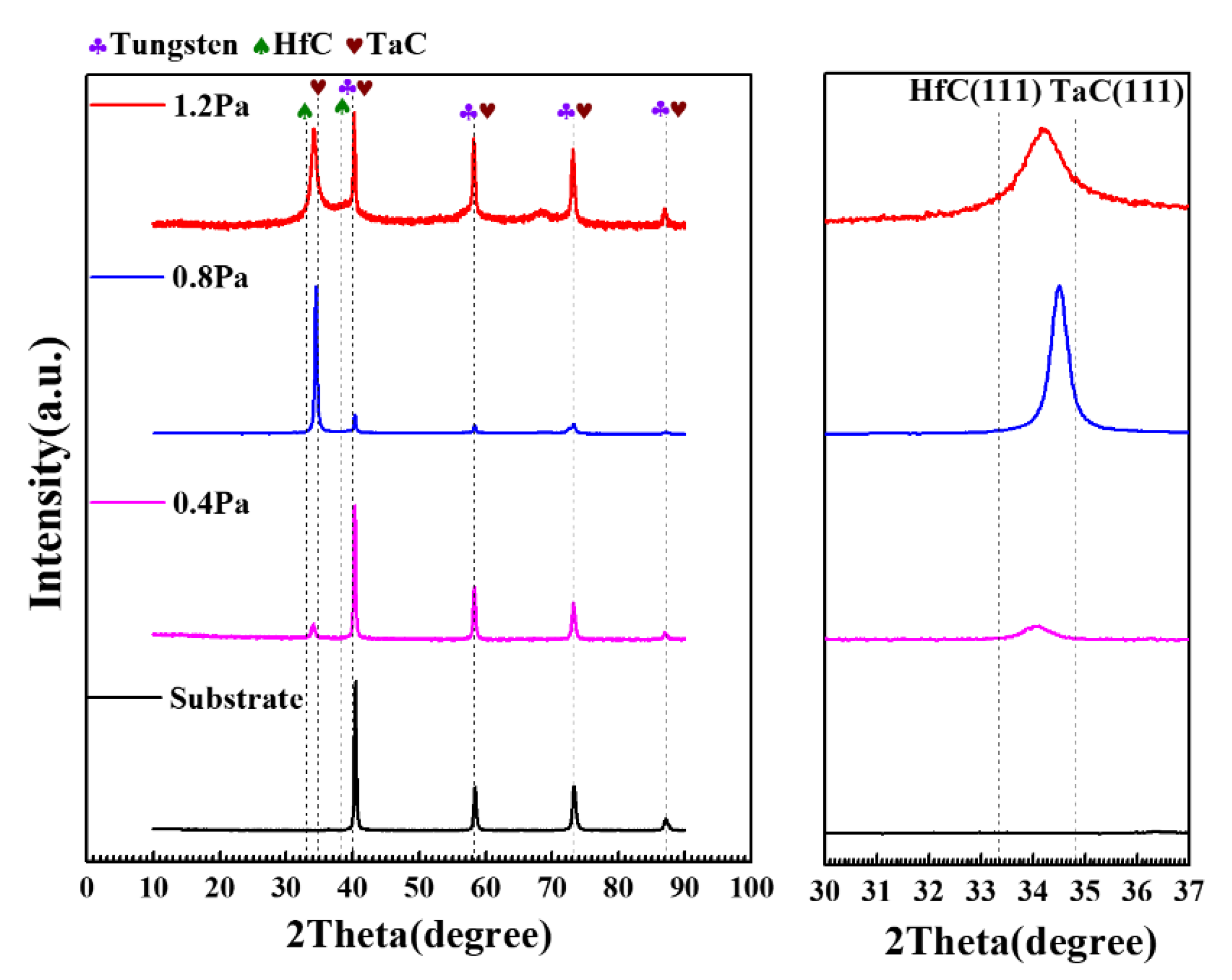
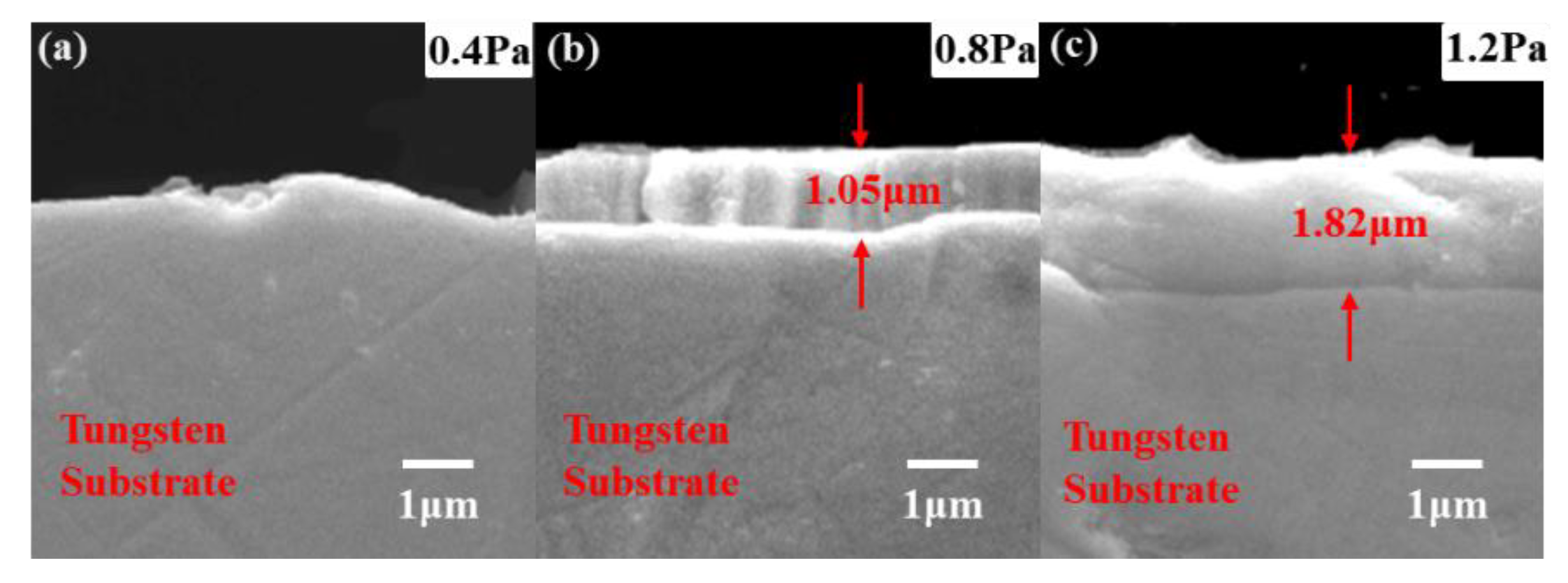
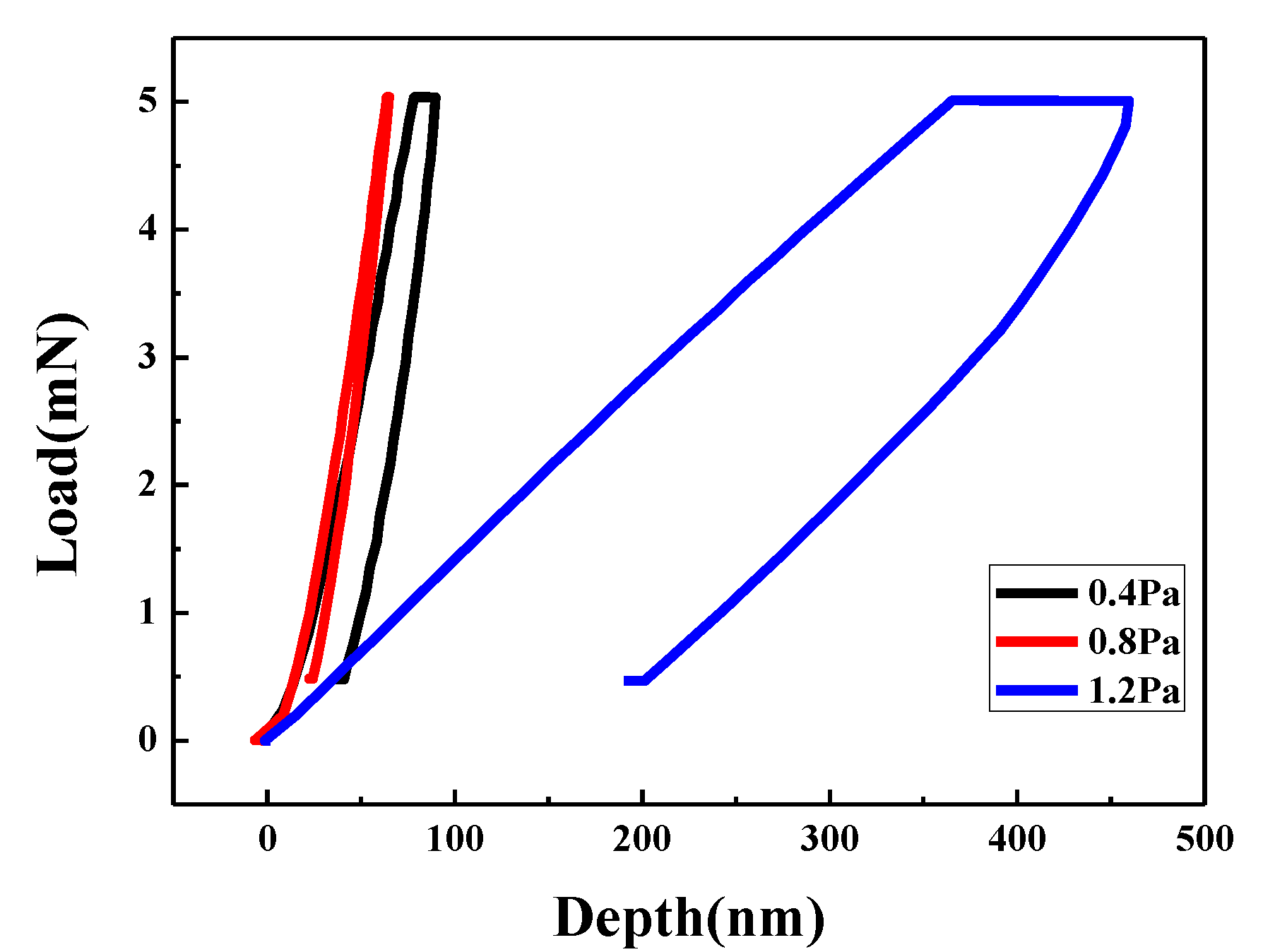
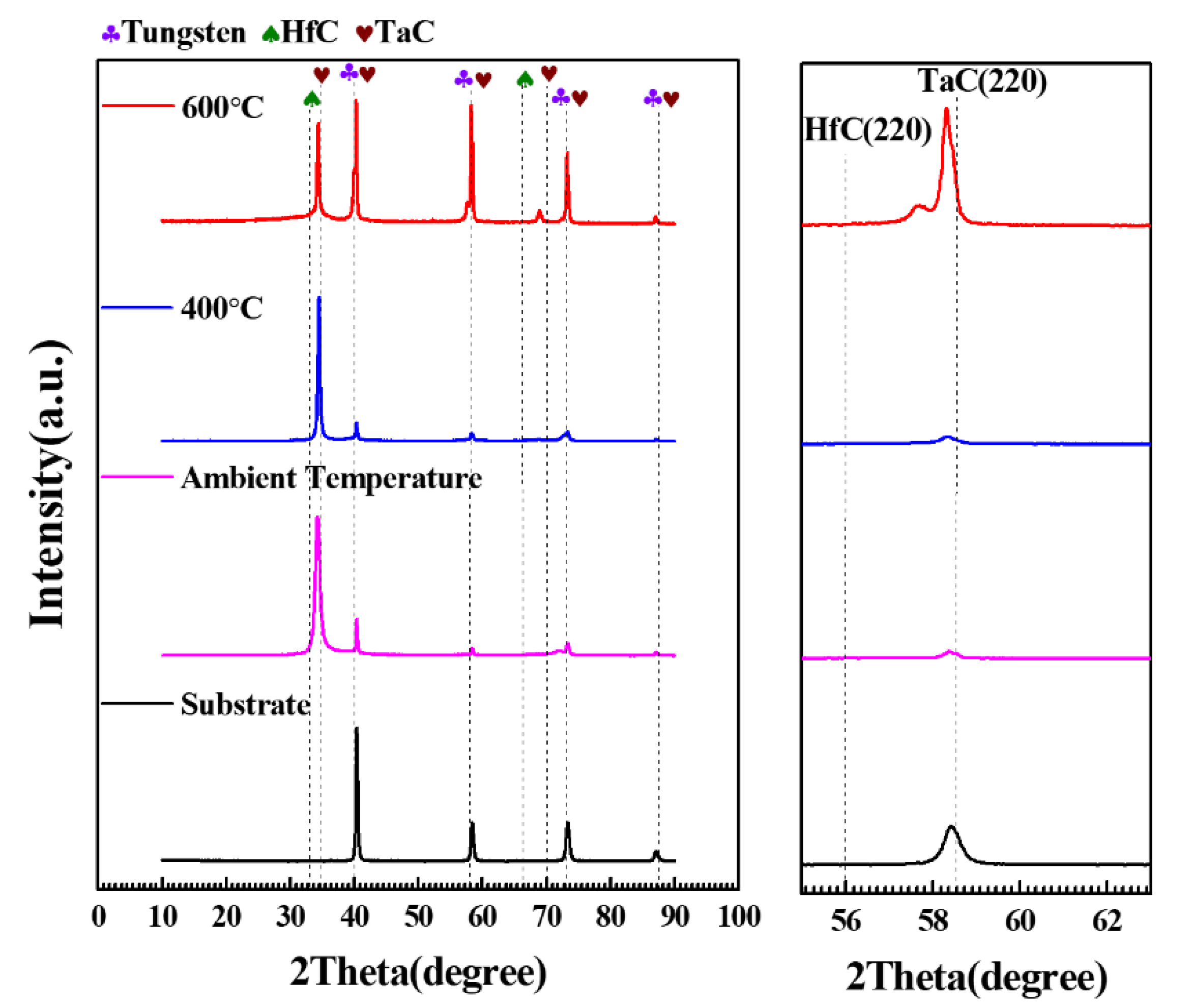

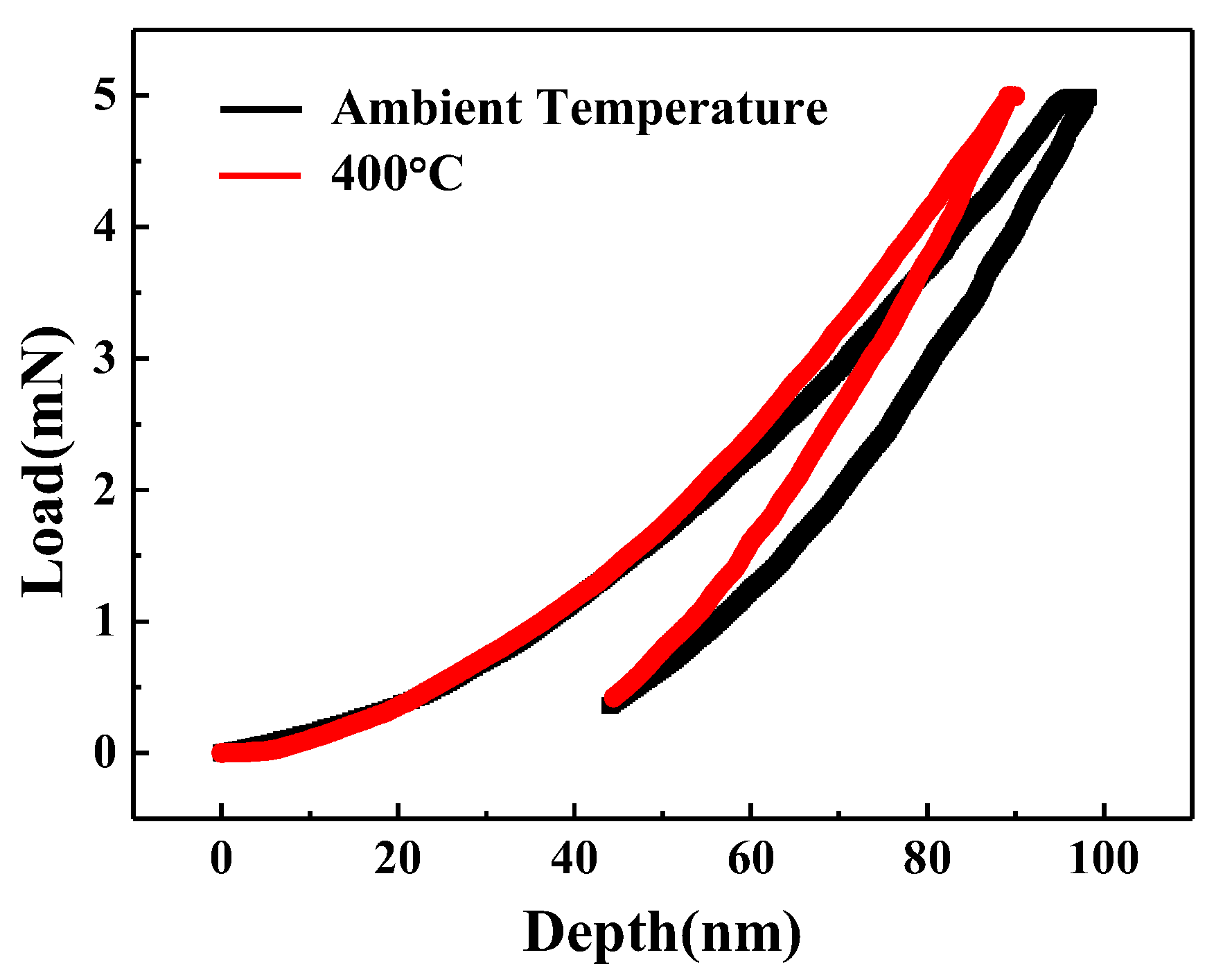
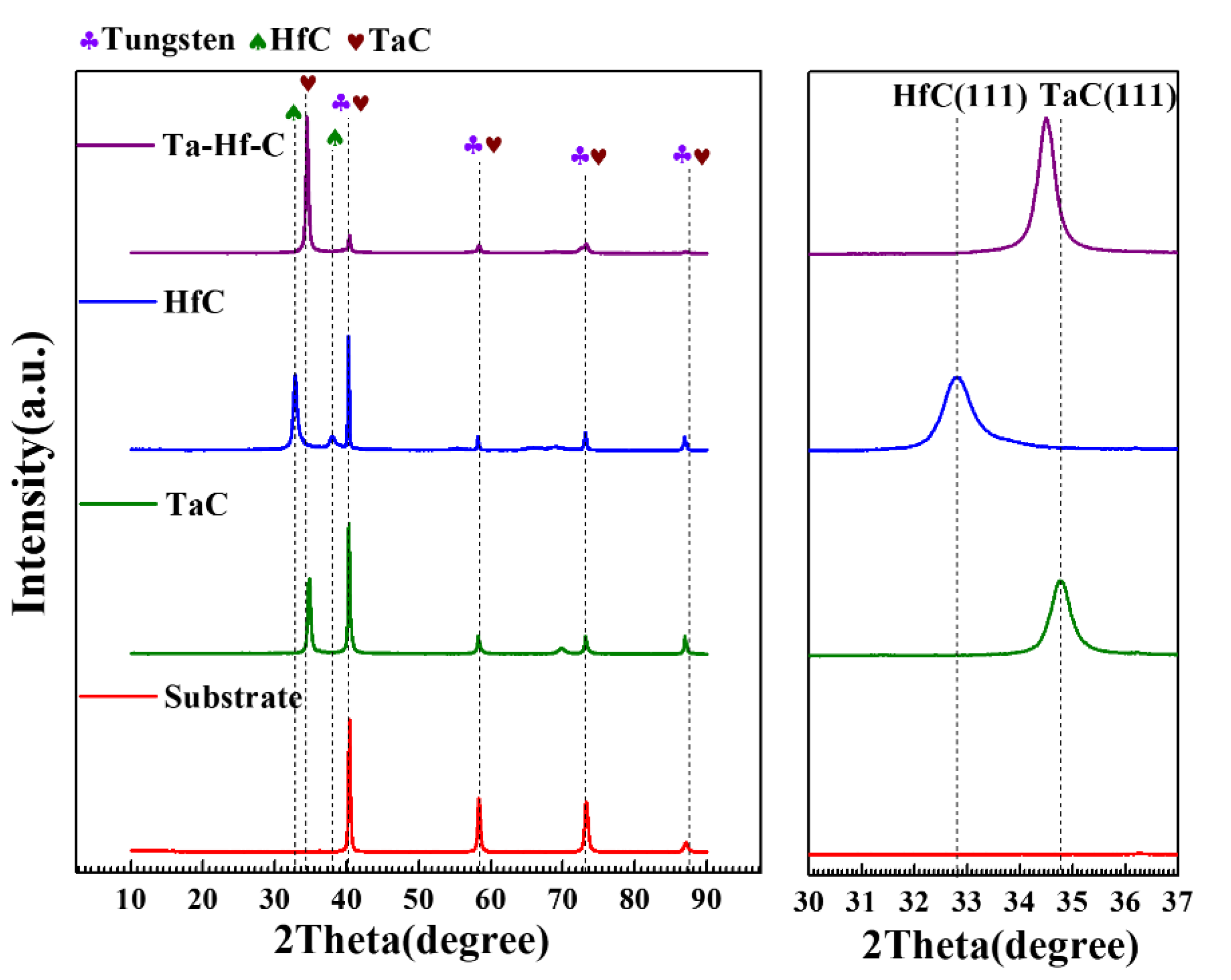
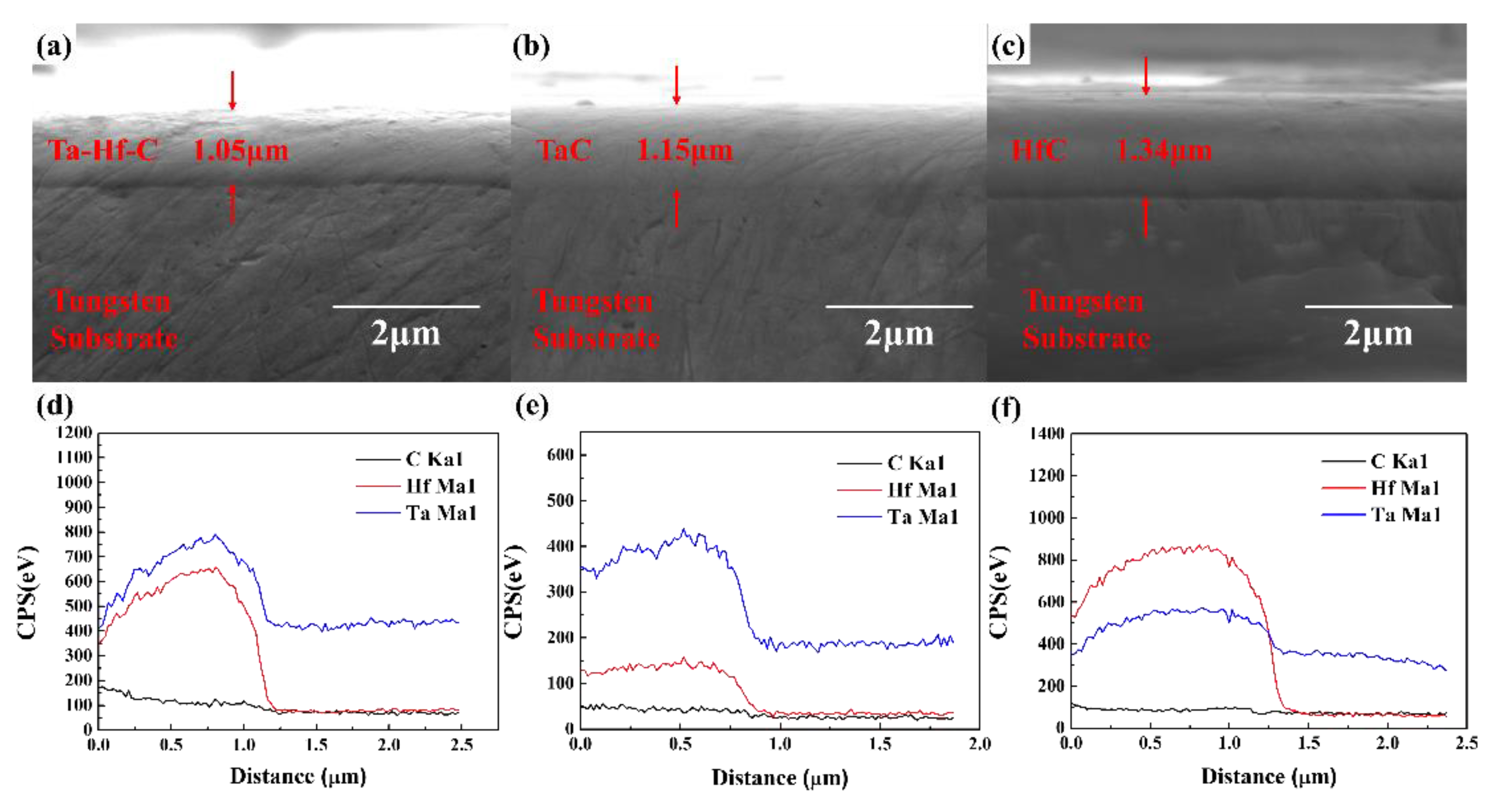
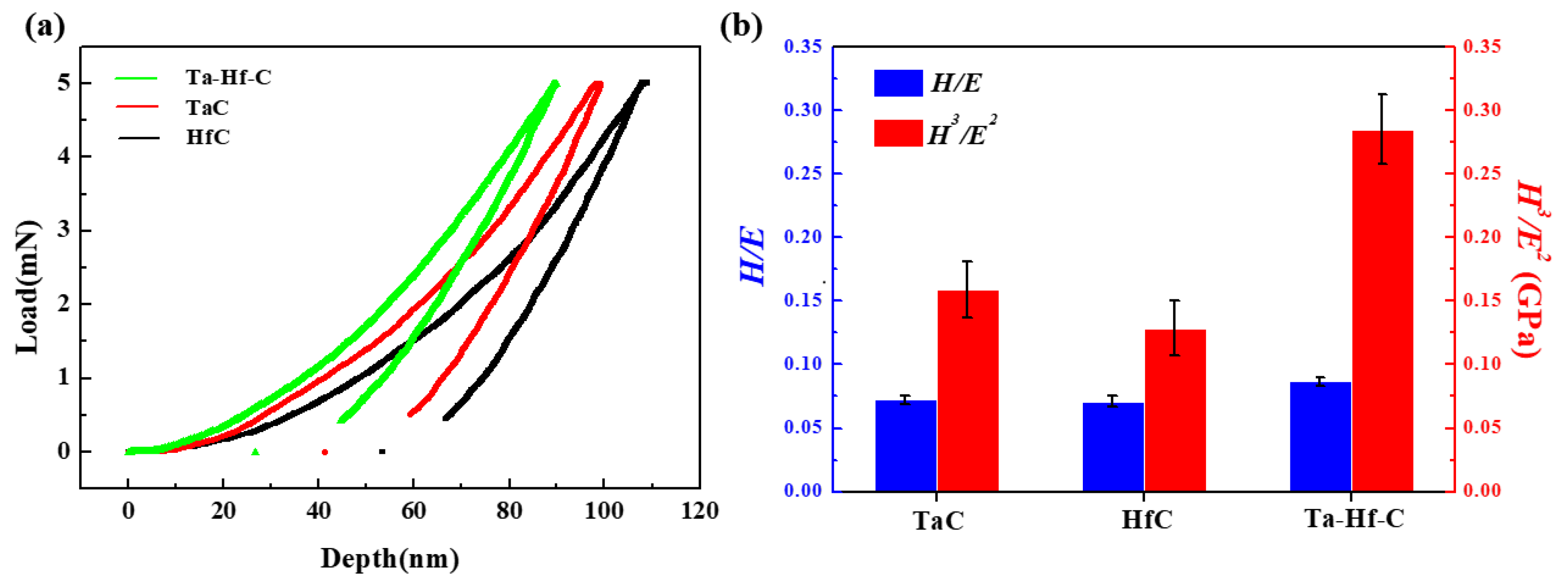
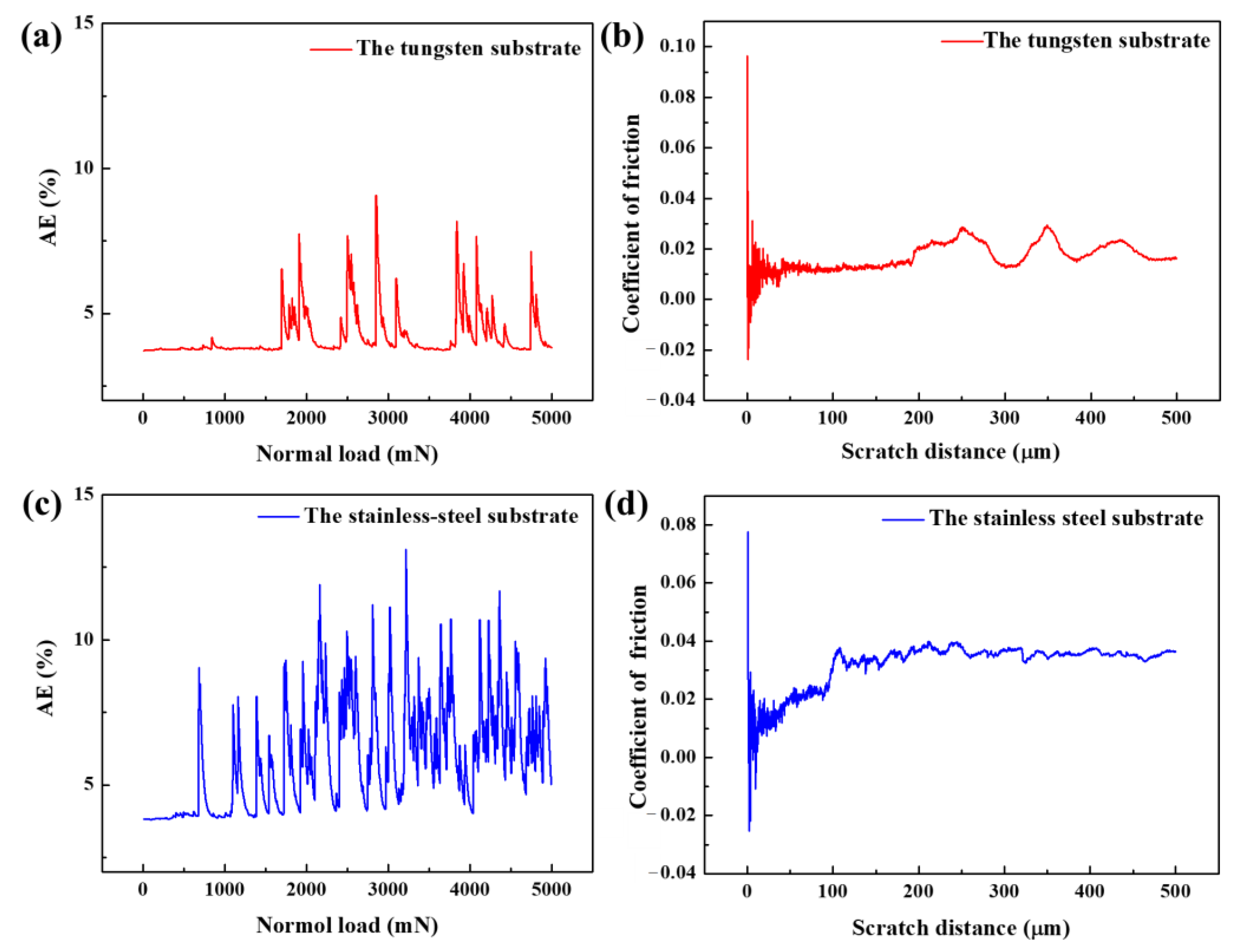
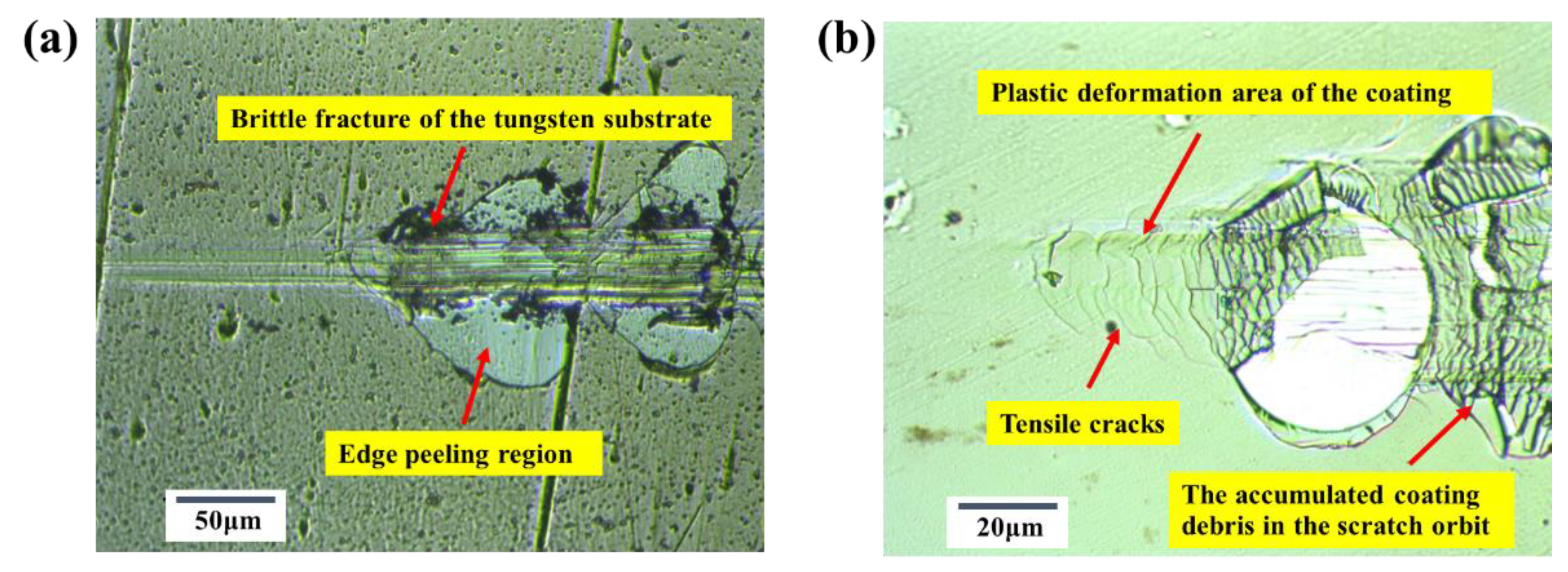
Publisher’s Note: MDPI stays neutral with regard to jurisdictional claims in published maps and institutional affiliations. |
© 2022 by the authors. Licensee MDPI, Basel, Switzerland. This article is an open access article distributed under the terms and conditions of the Creative Commons Attribution (CC BY) license (https://creativecommons.org/licenses/by/4.0/).
Share and Cite
Tan, Z.; Wu, X.; Yang, G.; Guo, J.; Zhu, W. Structure, Mechanical, and Micro-Scratch Behavior of Ta-Hf-C Solid Solution Coating Deposited by Non-Reactive Magnetron Sputtering. Materials 2022, 15, 4489. https://doi.org/10.3390/ma15134489
Tan Z, Wu X, Yang G, Guo J, Zhu W. Structure, Mechanical, and Micro-Scratch Behavior of Ta-Hf-C Solid Solution Coating Deposited by Non-Reactive Magnetron Sputtering. Materials. 2022; 15(13):4489. https://doi.org/10.3390/ma15134489
Chicago/Turabian StyleTan, Zhenyu, Xiang Wu, Guo Yang, Jinwei Guo, and Wang Zhu. 2022. "Structure, Mechanical, and Micro-Scratch Behavior of Ta-Hf-C Solid Solution Coating Deposited by Non-Reactive Magnetron Sputtering" Materials 15, no. 13: 4489. https://doi.org/10.3390/ma15134489





